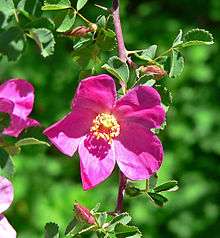Rosa willmottiae
Rosa willmottiae, Miss Willmott's rose[1] or Willmott's rose,[2] is a species in the genus Rosa in the plant family Rosaceae. It grows at an altitude of 2,300–3,150 metres (7,550–10,330 ft) in dry valleys in western Sichuan, China.[3] It forms an arching deciduous shrub 2–3 m (6 ft 7 in–9 ft 10 in) high, and as much across. The branches are covered in many straight prickles. The pinnate leaves typically have 7 to 9 small bluish-green leaflets which emit a pleasant fragrance when bruised.[4] It was introduced to western cultivation by Ernest Wilson in 1904 and was named after the collector and horticulturist Ellen Willmott. The flowers are small (25–40 millimetres or 1.0–1.6 inches), lilac-pink, and are borne on short laterals all along the length of the branches in late spring/early summer. The hips are small, becoming orange-red and losing their tips when ripe.
| Rosa willmottiae | |
|---|---|
 | |
| Scientific classification | |
| Kingdom: | Plantae |
| Clade: | Tracheophytes |
| Clade: | Angiosperms |
| Clade: | Eudicots |
| Clade: | Rosids |
| Order: | Rosales |
| Family: | Rosaceae |
| Genus: | Rosa |
| Species: | R. willmottiae |
| Binomial name | |
| Rosa willmottiae | |
Quest-Ritson & Quest-Ritson describe Rosa willmottiae as "one of the few wild roses that merits a place in a mixed border or even as a specimen shrub" and that when in flower it is "the embodiment of beauty".[5]
References
- "BSBI List 2007". Botanical Society of Britain and Ireland. Archived from the original (xls) on 2015-01-25. Retrieved 2014-10-17.
- "Rosa willmottiae". Natural Resources Conservation Service PLANTS Database. USDA. Retrieved 23 October 2015.
- Phillips, R. and Rix, M., Roses, Macmillan, 1994, p17
- Hillier Nurseries, The Hillier Manual of Trees and Shrubs, David & Charles, 1998, p592
- Quest-Ritson, C. & Quest-Ritson, B.,The Royal Horticultural Society Encyclopedia of Roses, Dorling Kindersley, 2003, p426
| Wikimedia Commons has media related to Rosa willmottiae. |